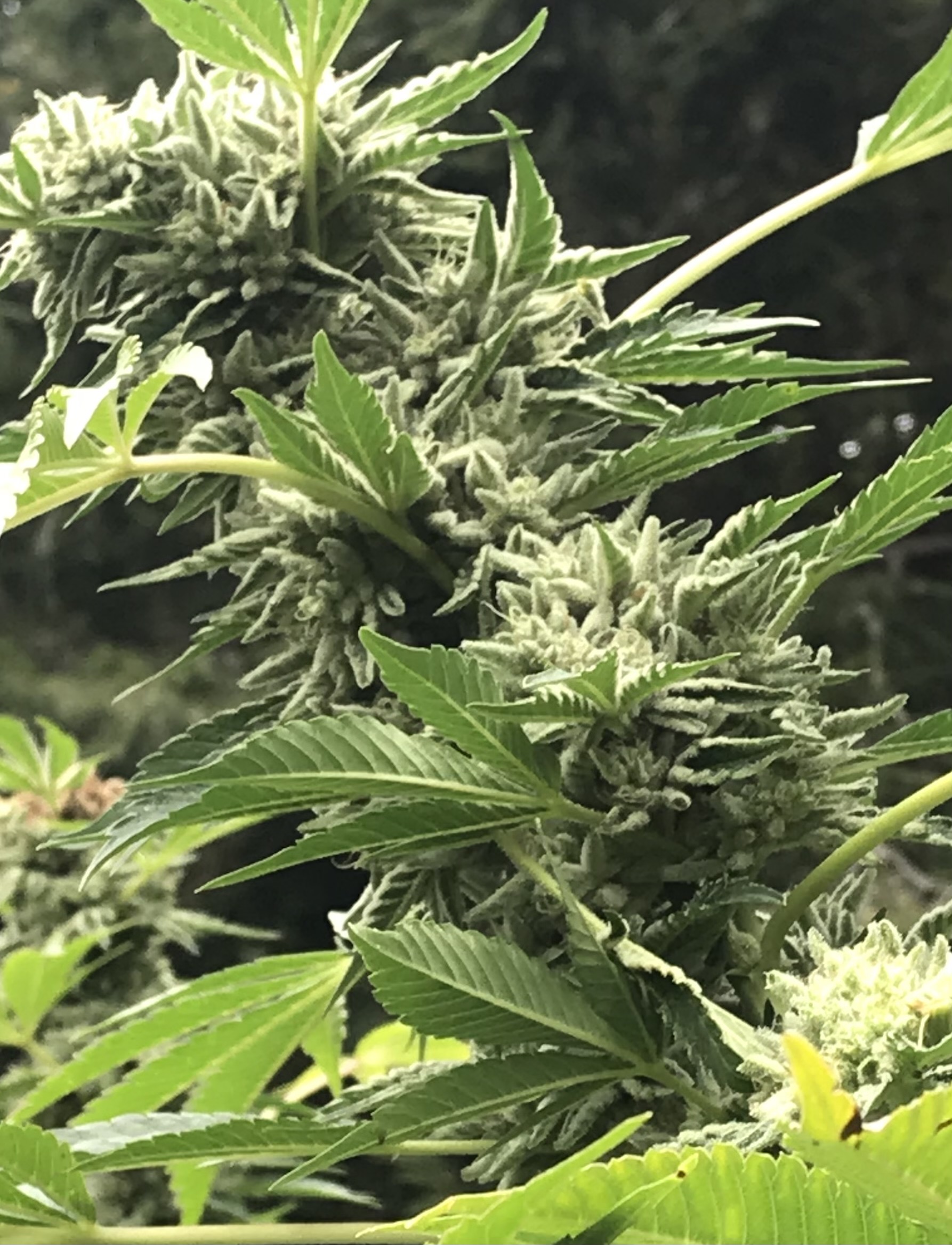Tips for when to cut and how to cure
Written By: Kathryn Shay
Hey B&W enthusiasts! It’s good to be back after the hiatus for the next turn around the sun, moon, and stars. I’m looking forward to continuing with helpful tips on growing cannabis alongside your herbs and vegetables, while we heighten our experiences of the grand finale together, smelling and eyeing the outrageous cannabis flowers this autumn in our backyard gardens.
D.I.Y. growing and using cannabis will still be the focus of this column. If you’ve been a loyal reader, you’ll notice some repetition from previous years, but please indulge me with my practice: I learn something new and try something different each season, and I’m always bringing new components into play. Everything is in flux. I am looking forward to upping our game in growing outrageous weed outdoors by creative exploration.
As September and October progresses, an increasing number of signs indicate that outrageous weed harvest time is happening or about to happen in our environments. Crickets chirping overwhelm the songs of birds. Blackberries have mostly been eaten and their leaves are turning red to indicate to the Aldo Leopolds (look him up) where to hunt for grouse. Mushroom foraging season ramps up as temperatures begin to drop. Rain is all in good time and the dwindling hours of daylight are upon us.
The Harvest moon on September 18 is appropriately in the sign of Aries, the ruler of Mars, with a partially eclipsed moon, not quite covering the solar disk — this is the time to get our Mars on and begin the delicate and demanding tasks of identifying pistil/tricome synchronicity, avoiding powdery mildew, flushing out any fertilizer or neem oil, and preparing to harvest the abundance of tricomed flowers between now and Sahmain, aka Halloween.
September’s weather brings the backyard growing season to a gradual close. The sun is waning, the photosynthesis process slows down, and the cooler air makes it harder to dry wet flowers during harvest time.

So, yes, it’s a confusing change of expectations, as last September we experienced very warm weather and needed to keep our plants watered like we would during the zenith of summer! The finality of flower development reminds growers to perfect the work of preventing that big buzz kill of powdery mildew, or gray mold, aka botrytis, aka bud rot.
Begin keen inspection for traces of powdery mildew or gray mold on the leaves and buds. Hopefully there won’t be the first signs of dry, brown leaves and/or tiny, hard-to-spot white dots (powdery mildew) on the green leaf. Fungus will increase quickly and cover the leaf if you don’t watch out for it and get rid of it immediately.
If there are any signs of mold, clip off affected leaves or buds with disinfected clippers (wipe clippers with vinegar or isopropyl alcohol between each cut). A foliar spray of sun tea made from water and organic compost (without fertilizer) may help stop the start of mold by applying the microorganisms from the compost tea.
Be sure air flow is substantial. Aerate the soil around the base of your plant and keep surrounding vegetation clear of your branches.
Indica strains will be very close to maturity by the end of the month. Sativas generally have a longer flowering period. When the Sativa plants begin to flower, it can take 70-90 days until they are ready to harvest, most likely towards the middle/end of October, with some plants lingering into the beginning of November.
Hybrid strains of Indica/Sativa, depending on the ratio, can fluctuate in maturity, anywhere from 42 to 70 days. Keeping close attention is the key to successful timing for determining exactly when to harvest in order to acquire your desired high.
Pistils are the hairs that grow on the stigma, the “flower” you’ll eventually smoke. They indicate to the grower the level of maturity. They’re longer and larger than trichomes, which are the “crystals” on your bud. These white hairs stick straight out when they first appear, then change color and structure as they mature. One of the indicators of a harvest-ready bud is when the pistil has curled inward with a soft orange hue.
Trichomes spring into view upon the buds and leaves during the late flowering phase. They first appear as clear glass mushroom-like structures that shift in color from transparent to a milky white and then amber. Take a picture and zoom in to get a closer look.
Balancing the pistil’s white/yellow/orange/amber hues and that of the trichomes’ move from clear to milky-white, with a whisper of amber, is key. This is an exchange of perfected synchronicity. Over-ripened flowers tend to bring a sense of deep relaxation to one’s character and possibly a harsher taste. A lot of the effects come down to the strain, but synchronized timing is a key factor.
Indica plants are probably going to be ready to harvest before next month’s curing and storing suggestions, so let’s prepare for the cutting and drying process that will consume close to two weeks of time.
Cutting a few days before rain and close to high noon is best, as the xylem will be pulling the energy/THC upward and high noon will give the sun time to dry any dew moisture from your buds. Definitely cut the plant down instead of pulling it up from the earth. Cutting keeps soil from getting on your buds.
Trimming and saving the fan leaves from the branches before you bring the branches inside onto a tarp will keep things less messy. These dry quickly in paper bags or on screens in a dark and dry environment.

Once your fresh flowers are cut, move your prime branches of buds out of the sunlight to dry. UV sunlight rays rapidly reduce your buds’ potency and the heat ruins the taste of the terpenes. Bringing the flower branches into a dark, dry, and well-ventilated environment, prevents the essential oils and terpenes from diminishing, while drying out the high moisture content from your flowers and stems. Moisture causes bacteria, mold, and yeast. Be cautious: Avoid mold!
Air circulation is necessary. Hanging the long-stemmed branches tied upside down from a rack or a clothesline without touching each other in a large closet (with a little fan), attic, or barn is ideal. Slow drying actually triggers the cannabinoids and will keep terpenes delicious.
It should take a good week or two until your weed is dry enough to start trimming, depending on factors of air circulation, humidity, temperature, and the size and density of your flowers. Delicately squeeze your flowers to decide the condition of the drying process; look for a crunchy, sticky, supple feel (save these trichome covered leaves when trimming for edibles, medicinal salves, and tinctures).
There is a lot of bustling needed to get your crop to dry, trimmed, and cured for safekeeping. Time is consequential when harvesting a superabundance of backyard grow.
Be gentle handling and trimming your flowers. Try to hold from the petiole, the base of the flower from the stem. This will help avoid damaging the trichomes. Try to get some latex gloves because the resin is ridiculously hard to get off your fingers, or you can just scrape the resin off into hashish balls and smoke it up.
Collect many airtight quart-sized, wide-mouthed jars; tinted jars are ideal, as they prevent UV sunlight from degrading your cannabis.
Put those sweet whole flowers loosely packed into your jars without crushing them.
Seal the jars and store them in a dark, dry, and cool environment. After the first week, open the jars for 5-10 minutes a few times a day. This allows the lingering moisture leaving the flowers to escape and bring in oxygen. After the first week of curing, open the jars every few days to let the flowers breathe for a few minutes.
Continue the curing process for at least 2-3 weeks. Storing your stash in a cool, dark, and dry environment will keep it at its best. Also some say Boveda packets ensure moisture control.
Labeling the date of the dry, cure, and strain of your weed is good info for the forgetful. Enjoy your organic, clean outrageous backyard weed with all the folks you love to be high with. I hope your garden is thriving and life is good.









